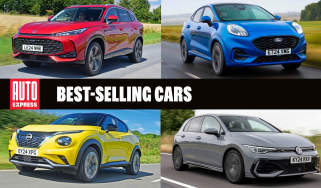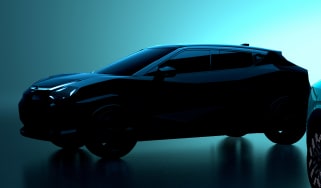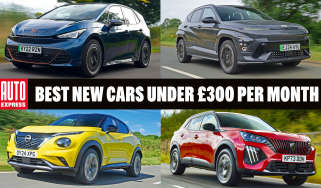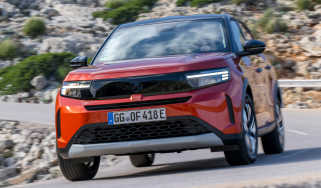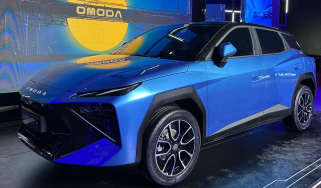New baby Nissan Juke EV on the way to challenge the Dacia Spring
Nissan to fast-track development of new battery-powered city car to take on forthcoming Volkswagen ID.1, and our exclusive images preview how it could look

Nissan is rushing a small crossover powered by an affordable electric drivetrain into production, to rival the Volkswagen ID.1. And the Japanese car maker, in the midst of a battle to turn around its flagging global business, is calling on family members Renault and Dacia to help deliver its new baby in late 2026.
The small crossover will tap into the components set of Renault’s reborn Twingo and its all-new lithium-iron phosphate (LFP) battery, to speed up the model’s introduction and help peg its cost below £20,000. That’s an impressive price for an electric car that will be assembled in eastern Europe, not China.
China is where the original version of its other sister car, the Dacia Spring, is assembled. But with new EU import tariffs eating into the Dacia’s profitability, its successor will surely be produced alongside the Twingo and Nissan at the Renault Group’s factory in Novo Mesto, Slovenia. The brands have long formed an alliance (also including Mitsubishi), initiated when Renault saved Nissan from bankruptcy in 1999.
New baby Nissan design
The smart money is on the new baby Nissan’s design being twinned with the Spring’s rather than the Twingo’s. That’s because the Renault city car has an unusual ‘monospace’ silhouette, with a slanting nose that fluidly blends into the windscreen.
Dacia’s Spring, in contrast, has a clear two-box shape with a distinct, horizontal front end, a slightly raised ride height and SUV design cues. Given Nissan’s 4x4 heritage kicking off with the 1951 Patrol and the popularity of SUVs, it makes sense for Nissan to tap into this bodystyle.
But given the tough economics of making ‘A-segment’ city cars pay, especially those with costly battery power, the vehicles will share at least 80 per cent of their componentry. Renault has adopted the Stellantis way of making windscreen, glasshouse and door structure common to multiple vehicles, so it’ll be down to the front and rear ends to deliver the Nissan family look. Nissan Design Europe, based in London, is sure to have influenced the styling.
Engineering and development
The engineering is being led by Renault’s EV and software division Ampere. Back in 2024, then CEO of Nissan Makoto Uchida said: “Nissan has asked Ampere to explore the development of the A-segment car for Europe.
“With Ampere we are targeting a very short development time. This car will deliver the convenience and advanced functionality that customers expect, but in a small-sized EV at an affordable price.”
Renault Group CEO Luca de Meo established Ampere to speed up its electric cars’ development time to better compete with fast-moving Chinese rivals. Taking just two years, the new Twingo is the fastest-engineered car in Renault history; the new Renault 5 took three years and the Megane E-Tech four.
The secret sauce was setting up an R&D skunkworks in China to learn from the experts themselves. The Advanced China Development Centre (ACDC) is a small operation of 150 people empowered to make decisions in days, not weeks, Ampere’s powertrain and EV engineering boss Philippe Brunet told Auto Express.
“We selected some key, competitive partners in China who we work with. This is the best way to get competitive very fast.”

The reason the Twingo could be engineered in 24 months was because it has the Renault 5’s vehicle architecture at its heart. “We are reusing the Ampere Small platform where we have changed the wheelbase: the car is less than four metres long. This is the same e-architecture and we redevelop the battery, [add a] new e-powertrain and the top hat (new body) – this we did in two years.”
And that development work can be scaled across sister models, including the A-segment Nissan and more. “The Dacia model is a sister car of the Twingo and it’s [also] developed in China,” explained Brunet.
That means embedding a small design team there to digitally model their ideas, creating the 3D development data for the engineering team to use. “Usually in our process, I would say the convergence takes about three months. In China, they’re able to make it in five weeks.”
Size, battery and range
The new trio are expected to be around 3.75-metres long, shorter than the new MINI Cooper. The wheelbase is about 2.5m-long and will accommodate the battery pack.
The headline news is that the triplets will use LFP batteries. Pioneered in EVs by Chinese car maker BYD, lithium-iron phosphate cathodes don’t include expensive cobalt but the downside is they’re less energy-dense than NMC batteries. This can be offset by using clever designs to cram more cells into the battery module, and using a heat pump to improve their inferior cold-weather performance.
“Using LFP is only part of the cost competitiveness,” explained Brunet. “The cost gap between LFP and NMC is eight to 15 per cent.
“The other way to get the cost down is to have an efficient car. That allows you to reduce the battery which is the main lever to reduce the cost of the car – it’s between 30 and 45 per cent of its total,” he said.
Given this is the group’s first European LFP pack, most likely supplied by CATL in Hungary, it’s difficult to predict the three A-segment cars’ battery sizes. Today’s Dacia Spring, which is a little shorter and has a slightly smaller wheelbase than the new models harbours a 26.8kWh battery.
That’s capable of just 142 miles on the WLTP cycle. But Dacia’s product development boss, Patrice Lévy-Bencheton, told Auto Express that range was sufficient for the city car’s typical customer usage. Dacia’s data calculates the average daily trip at 27km (17 miles).
Prices and performance
“We define our cars according to customer needs and this helps us position the Spring as the most affordable EV by far. We will bring in our new A-segment EV at below €18,000,” said Lévy-Bencheton. In the UK the Spring currently starts at £14,995 for the 44bhp entry version.
It’s likely that the Nissan will, along with the Twingo, pack additional battery modules to boost range. And the Nissan’s aerodynamic design and inherent efficiency – the platform will supposedly be good for more than 6 miles per kWh – should boost the range close to 200 miles.
Performance will also beat that of today’s Spring, whose higher-output motor sends just 64bhp to the front wheels. Nissan and Renault both use the same electrically excited synchronous motor design, known for their efficiency and lack of rare earths in the rotor’s magnets. Expect the Nissan to offer the 94bhp and 121bhp e-motors from the Renault 5, driving the front wheels.
Despite Japan’s love of tiny kei cars, Nissan doesn’t have a lot of form in the European city car segment. It did sell the Pixo between 2009 and 2013. Its 2026 successor is also a collaboration with other brands. But the hi-tech, electric, Euro-centric baby Nissan will be in another league entirely.
Click here for our list of the best small electric cars...
Find a car with the experts


